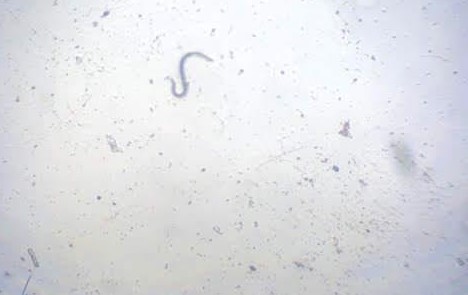Biological control in the management of Pratylenchus brachyurus under different treatments in soybean crop
DOI:
https://doi.org/10.20873/jbb.uft.cemaf.v9n3.coelhoKeywords:
biocontrol, root lesions, nematodes, Glycine maxAbstract
The soybean culture has great importance for the Brazilian economy and may face biotic and abiotic barriers in its production, with nematodes being exponents in reducing the productivity of this culture. Thus, this work aimed to evaluate the effect of biological products for the control of Pratylenchus brachyurus in soybean culture. The experiment was carried out in the greenhouse and in the Phytopathology and Nematology Laboratory of University Center Católica do Tocantins. The experimental design was completely randomized, consisting of five treatments with different biological products: T1 - control (without treatment), T2 - Presence® (Bacillus subtilis and Bacillus licheniformis), T3 - Votivo Prime® (Bacillus firmus), T4 - Ecotrich® (Trichoderma harzianum) and T5 - Nemat® (Paecilomyces lilacinus) with four replications. To evaluate the efficiency of the biological control of nematodes, the soybean seeds were previously treated at the time of sowing. Seed treatment was carried out individually, adding the products according to the dosage established in the package insert. At 30 days after inoculation, characteristics, root length, plant size, number of nematodes and severity were evaluated. The products used did not affect the root length and the number of nematodes. The product T3 - Votivo Prime®, presented the best result when evaluating the plant length. The severity was lower when using some type of product for biological control.
References
Araújo FFD, Bragante RJ, Bragante CE. Controle genético, químico e biológico de meloidoginose na cultura da so-ja. Pesquisa Agropecuária Tropical, v.42, p.220-224, 2012.
Barbosa JC, Maldonado Junior W. AgroEstat: sistema para análises estatísticas de ensaios agronômicos. Jaboticabal, FCAV/UNESP. 396p, 2015.
Conab, 2020. Boletim da safra de grãos. 11º Levantamento - Safra 2019/20- Safra 2019/20. Disponível em: https://www.conab.gov.br/info-agro/safras/graos/boletim-da-safra-de-graos. Acesso em 11 dez. 2020.
Costa NL, Santana AC, Coronel DA, Brum AL, Mattos CAC. Aspectos da importância do complexo soja no Brasil e no Rio Grande do Sul: 1997–2017. Redes (St. Cruz Sul, Onli-ne), v.25, n.4, p.1840-1863, 2020. http://dx.doi.org/10.17058/redes.v25i4.12735.
Cruz TT, Asmus GL, Garcia RA. Espécies de Crotalaria em sucessão à soja para o manejo de Pratylenchus brachyu-rus. Ciência Rural, v.50, n.7, 2020. https://doi.org/10.1590/0103-8478cr20190645.
Figueiredo A. Estudo de variáveis ecológicas de Pratylenchus brachyurus em soja e elaboração de uma escala de notas pa-ra seleção de genótipos a campo. Ano de obtenção: 2013. 86 f. Tese (Doutorado em Agronomia) – UNESP, Jaboticabal.
Grigolli JFJ, Asmus GL. Manejo de nematoides na cultura da soja. Manejo de nematoides na cultura da soja. Embrapa Agropecuária Oeste-Capítulo em livro científico (ALICE), 2014.
Koenning SR, Wrather JA, Kirkpatrick TL, Walker NR, Starr JL, Mueller JD. Plant-parasitic nematodes attacking cotton in the U.S.: old and emerging problems. Plant Disease, v.8, n.2, p.100-113, 2004.
Machado AP, Costa MJN. Biocontrole do fitonematoide Pratylenchus brachyurus in vitro e na soja em casa de vege-tação por Bacillus subtilis. Revista Biociências, v.23, n.1, p.83-94, 2018.
Oliveira MKDS, Chaves A., Vieira DADN, da Silva EJ, Walber DDL. Controle biológico de fitonematóides do gê-nero Pratylenchus através deinoculante natural em cana-de-açúcar. Revista Brasileira de Ciências Agrárias,Recife, v.6, n.2, p.203-207, 2011. DOI:10.5039/agraria.v6i2a835.
Rezende AA. Efficiency of different commercial products with Trichoderma spp. for the control of Sclerotinia stem rot of soybean. 2011. 133 f. Dissertação (Mestrado em Ciências Agrárias) - Universidade Federal de Uberlândia, Uberlândia.
Santos ARB, Almeida FAD, Leite MLT, Fonseca WL, Alcân-tara Neto FD, Pereira FF, Santos TSD. Biocontrole no ma-nejo de Pratylenchus brachyurus na soja. Revista de Ciên-cias Agrárias, v.42, n.3, p.201-210, 2019. http://dx.doi.org/10.19084/rca.17201.
Silva RA, Nunes NA, Santos TFS, Iwano FK. Efeito da rota-ção e sucessão de culturas no manejo de nematoides da soja em área arenosa. Nematropica, v.48, n.2, p.198-206, 2018.
Soares R, Dias W. Manejo de nematoides da soja: escolha o milho certo! Embrapa Soja-Fôlder/Folheto/Cartilha (INFO-TECA-E), 2020.
Sundararaju P, Jeyabaskaran KJ. Evaluation of different soil types on multiplication of Pratylenchus coffeae and growth of banana seedlings var. Nendran. Nematologia Mediterra-nea, v.31, n.2, 2003.
Usda - United States Departamente of Agriculture. 2020. World Agricultural Production. Disponível em: https://downloads.usda.library.cornell.edu/usdaesmis/files/5q47rn72z/dz0117445/qv33sf19j/production.pdf> Acesso em: 29 abr. 2020.

Downloads
Published
How to Cite
Issue
Section
License
Copyright (c) 2024 - Journal of Biotechnology and Biodiversity

This work is licensed under a Creative Commons Attribution 4.0 International License.
Authors who publish with this journal agree to the following terms:
Authors retain copyright and grant the journal right of first publication with the work simultaneously licensed under a Creative Commons Attribution License (CC BY 4.0 at http://creativecommons.org/licenses/by/4.0/) that allows others to share the work with an acknowledgement of the work's authorship and initial publication in this journal.
Authors are able to enter into separate, additional contractual arrangements for the non-exclusive distribution of the journal's published version of the work (e.g., post it to an institutional repository or publish it in a book), with an acknowledgement of its initial publication in this journal.
Authors are permitted and encouraged to post their work online (e.g. in institutional repositories or on their website) prior to and during the submission process, as it can lead to productive exchanges, as well as earlier and greater citation of published work (Available at The Effect of Open Access, at http://opcit.eprints.org/oacitation-biblio.html).


